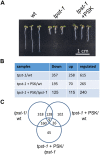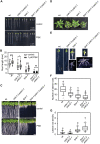Tyrosylprotein sulfotransferase-dependent and -independent regulation of root development and signaling by PSK LRR receptor kinases in Arabidopsis
- PMID: 34028532
- PMCID: PMC8318253
- DOI: 10.1093/jxb/erab233
Tyrosylprotein sulfotransferase-dependent and -independent regulation of root development and signaling by PSK LRR receptor kinases in Arabidopsis
Abstract
Tyrosine-sulfated peptides are key regulators of plant growth and development. The disulfated pentapeptide phytosulfokine (PSK) mediates growth via leucine-rich repeat receptor-like kinases, PSKR1 and PSKR2. PSK receptors (PSKRs) are part of a response module at the plasma membrane that mediates short-term growth responses, but downstream signaling of transcriptional regulation remains unexplored. In Arabidopsis, tyrosine sulfation is catalyzed by a single-copy gene (TPST; encoding tyrosylprotein sulfotransferase). We performed a microarray-based transcriptome analysis in the tpst-1 mutant background that lacks sulfated peptides to identify PSK-regulated genes and genes that are regulated by other sulfated peptides. Of the 169 PSK-regulated genes, several had functions in root growth and development, in agreement with shorter roots and a higher lateral root density in tpst-1. Further, tpst-1 roots developed higher numbers of root hairs, and PSK induced expression of WEREWOLF (WER), its paralog MYB DOMAIN PROTEIN 23 (MYB23), and At1g66800 that maintain non-hair cell fate. The tpst-1 pskr1-3 pskr2-1 mutant showed even shorter roots, and higher lateral root and root hair density than tpst-1, revealing unexpected synergistic effects of ligand and PSKR deficiencies. While residual activities may exist, overexpression of PSKR1 in the tpst-1 background induced root growth, suggesting that PSKR1 may be active in the absence of sulfated ligands.
Keywords: Arabidopsis; atrichoblast; phytosulfokine; root development; root hair; sulfated peptide signaling; transcriptome; tyrosylprotein sulfotransferase.
© The Author(s) 2021. Published by Oxford University Press on behalf of the Society for Experimental Biology.
Figures







Similar articles
-
Phytosulfokine peptides, their receptors, and functions.Front Plant Sci. 2024 Jan 5;14:1326964. doi: 10.3389/fpls.2023.1326964. eCollection 2023. Front Plant Sci. 2024. PMID: 38250441 Free PMC article. Review.
-
Phytosulfokine control of growth occurs in the epidermis, is likely to be non-cell autonomous and is dependent on brassinosteroids.Plant J. 2013 Feb;73(4):579-90. doi: 10.1111/tpj.12056. Epub 2012 Dec 10. Plant J. 2013. PMID: 23083315
-
Phytosulfokine peptide signaling controls pollen tube growth and funicular pollen tube guidance in Arabidopsis thaliana.Physiol Plant. 2015 Apr;153(4):643-53. doi: 10.1111/ppl.12270. Epub 2014 Oct 8. Physiol Plant. 2015. PMID: 25174442
-
Phytosulfokine-α controls hypocotyl length and cell expansion in Arabidopsis thaliana through phytosulfokine receptor 1.PLoS One. 2011;6(6):e21054. doi: 10.1371/journal.pone.0021054. Epub 2011 Jun 16. PLoS One. 2011. PMID: 21698171 Free PMC article.
-
Phytosulfokine peptide signalling.J Exp Bot. 2015 Aug;66(17):5161-9. doi: 10.1093/jxb/erv071. Epub 2015 Mar 9. J Exp Bot. 2015. PMID: 25754406 Review.
Cited by
-
A novel LRR receptor-like kinase BRAK reciprocally phosphorylates PSKR1 to enhance growth and defense in tomato.EMBO J. 2024 Dec;43(23):6104-6123. doi: 10.1038/s44318-024-00278-z. Epub 2024 Oct 24. EMBO J. 2024. PMID: 39448885 Free PMC article.
-
Phytosulfokine downregulates defense-related WRKY transcription factors and attenuates pathogen-associated molecular pattern-triggered immunity.Plant J. 2024 Dec;120(6):2367-2384. doi: 10.1111/tpj.17115. Epub 2024 Dec 11. Plant J. 2024. PMID: 39661720 Free PMC article.
-
Combined Bulked Segregant Analysis-Sequencing and Transcriptome Analysis to Identify Candidate Genes Associated with Cold Stress in Brassica napus L.Int J Mol Sci. 2025 Jan 28;26(3):1148. doi: 10.3390/ijms26031148. Int J Mol Sci. 2025. PMID: 39940915 Free PMC article.
-
Integrative Transcriptomics Data Mining to Explore the Functions of TDP1α and TDP1β Genes in the Arabidopsis thaliana Model Plant.Genes (Basel). 2023 Apr 9;14(4):884. doi: 10.3390/genes14040884. Genes (Basel). 2023. PMID: 37107642 Free PMC article.
-
Phytosulfokine peptides, their receptors, and functions.Front Plant Sci. 2024 Jan 5;14:1326964. doi: 10.3389/fpls.2023.1326964. eCollection 2023. Front Plant Sci. 2024. PMID: 38250441 Free PMC article. Review.
References
-
- Benjamini Y, Hochberg Y. 1995. Controlling the false discovery rate: a practical and powerful approach to multiple testing. Journal of the Royal Statistical Society 57, 289–300.
-
- Chen YF, Matsubayashi Y, Sakagami Y. 2000. Peptide growth factor phytosulfokine-alpha contributes to the pollen population effect. Planta 211, 752–755. - PubMed
Publication types
MeSH terms
Substances
LinkOut - more resources
Full Text Sources
Other Literature Sources
Molecular Biology Databases
Miscellaneous

